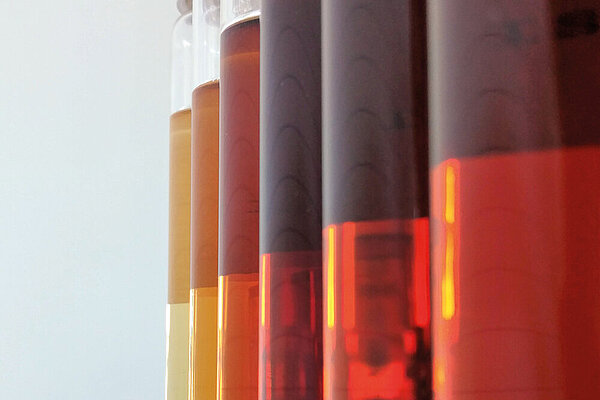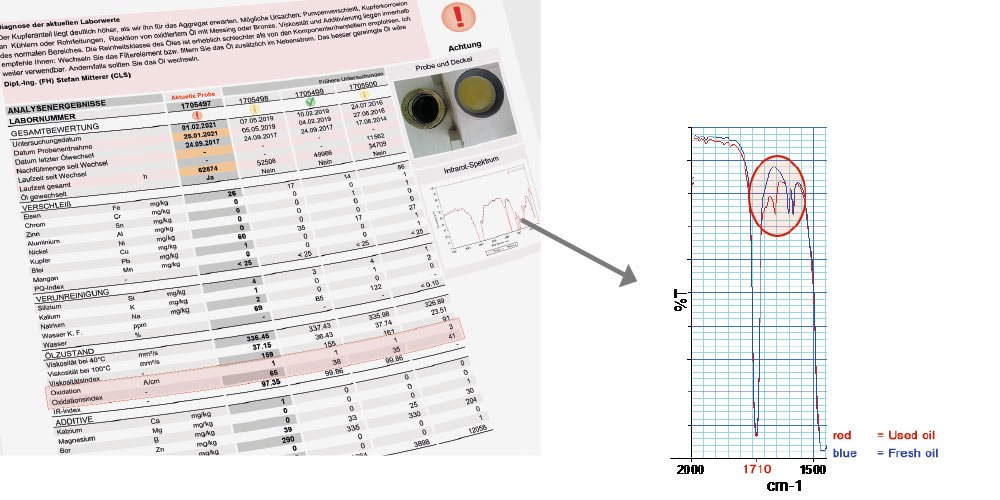Oxidation index – Modern lubricants age differently
Every lubricant ages over the course of its service life. The extent to which an ageing process has progressed is shown in the laboratory report in particular by the "oxidation" data. Among other analytical values, the oxidation value allows conclusions to be drawn about the remaining operating time of the oil. Oxidation is determined by IR spectroscopy in accordance with DIN 51453. This is done by passing infrared light through an oil-filled cell. The decrease in light intensity is measured as absorption. This method has already been defined at times when often simply refined mineral oils were used as base oils. Nowadays, for higher grade Group II or III oils or for partially synthetic or fully synthetic base products, oxidation can often no longer be determined with the relatively simple method, which is only defined for a certain "wave number".
OELCHECK has therefore further developed the method for detecting oxidation. Below the "oxidation" value, which is stated in absorption/cm oil layer thickness (A/cm), modern oils have recently also been given the dimensionless "oxidation index" in the laboratory report. While for oxidation in A/cm at a specific point in the graph, at a "band" at a wave number of 1710 cm-1 , the change in length compared to the base spectrum is calculated in cm, the index is based on an area calculation. In a differential spectrum, the oxidation index therefore not only looks at the change in length of a single peak, but also determines a change in area that can be calculated in a range between two wave numbers in which oxidative changes occur. The number listed in the laboratory report under "Oxidation Index" essentially corresponds to the increase in this oxidation area in cm². OELCHECK tribologists determined the left and right wave numbers and thus the calculation range for the oxidation index, depending on different oils or their intended use. Thanks to the oxidation index defined in this way, in contrast to the pure DIN line calculation in A/cm, the oxidation of modern lubricants can also be detected at a very early stage. The oxidation index thus provides reliable information for an upcoming oil change.

Table of contents
Oxidation in A/cm
As mineral oils age, oxygen molecule chains form double bonds to certain hydrocarbon compounds in the oils and form new molecular chains. When infrared light passes through these molecular chains, this light is absorbed more readily than in fresh oil. By subtracting the used and fresh oil spectrum, the oxidation is indicated in the laboratory report as "absorption of the IR radiation" in (A/cm), which refers to a path length of one centimetre (oil layer thickness) of the measuring cell.
A standard reaches its limits
When determining oxidation using IR spectroscopy in accordance with DIN 51453, it is assumed that a clear peak can be seen in the IR spectrum of an oxidized oil at a wave number of 1,710 cm-1 , which is influenced by the oxygen double bonds. This wave number was therefore used as the basis for the oxidation determination of mineral oil-based used oils from engines and industrial lubricants.
In today’s lubricants, which use better refined or partly synthetic base oils or modern additive technologies, however, the peak-based approach no longer provides sufficiently interpretable findings. Even in trend analyses over several 10,000-hour periods, OELCHECK tribologists are increasingly confronted with oxidation values that hardly change, although changes in viscosity, acids or oxidation inhibitors indicate an increasing ageing of the lubricant.
Many of the newer lubricants contain synthetic base oils based on esters. In these oils, not only do the wear protection additives have a better effect, they are also more temperature-stable and age less. These synthetic long-term oils are particularly advantageous for oils in systems where oil changes are complex and expensive, or which run at high temperatures. In oil analyses, however, it is detrimental that oxidation can no longer be detected because the ester components in the IR spectrum overlap precisely in the area with the oxygen double bonds in which oxidation is calculated according to the DIN method. Oxidation also cannot be calculated for lubricants that contain viscosity index improvers (VI-improvers) or special additives that already have a clear peak area at 1,710 cm-1 in fresh oil. For modern lubricants, the specification of oxidation according to DIN 51453 is in many cases extremely inaccurate; for oils with ester components, oxidation according to DIN cannot be specified. To ensure that accurate information on oil ageing is also possible for lubricants for which DIN oxidation cannot be determined, OELCHECK tribologists have taken into account the increase in viscosity, the reduction in additive content, the degradation of antioxidants as well as the increase in AN (acid number) and, in the case of motor oils, the decrease in BN (base number).
Oxidation index – more meaningful as it is surface-based
Because the proportion of lubricants for which line-based IR oxidation determination was no longer reliable or impossible increased, OELCHECK tribologists provided the solution. After comparing various inspection and test procedures with differently aged oils from a wide range of applications, as well as after intensive discussions with lubricant and machine manufacturers, the solution is definite: IR spectroscopy is also used for the new oxidation index. But instead of only looking at the change in length defined in DIN at the peak oxidation of 1,710, the focus for the oxidation index is on the range of the IR spectrum between 1,500 and 1,700 cm-1 . With this area-based calculation method, the lateral limits can be defined depending on the oil type, so that they always reflect the change caused by oxidation. This means that any influences or overlays caused by lubricant components such as oxidation inhibitors, VI improvers or other additives can be eliminated.
Here is an example of this: The performance of the area-based oxidation index is exemplary when considering a synthetic gear oil from a wind turbine: Mineral gear oil was used until 2016. In July 2016, an oxidation of 3 A/cm was clearly determined for this. However, after switching to the synthetic product, the conventional method could no longer determine a meaningful oxidation value. In the IR spectrum from February 2021 (see bottom right), one peak overlaps the other at a wave number of 1,710 cm-1 . Any oxidation of the oil is not perceptible. However, if the last three IR spectra are subsequently considered area-based, the oxidation index provides a much more differentiated picture of oil oxidation.
The beginning ageing process of the oil would have already been discovered with the oxidation index in February 2019. Long before this, an even stronger PAI (Peak Area Increase) = 65 cm² increase in the IR spectrum was observed in February 2021 between the two wave number limits defined for this oil type by OELCHECK.

Oxidation index – now in use
OELCHECK now determines the oxidation index for certain synthetic gear oils, for some turbine oils and for fluids from stationary hydraulic systems and compressor oils for which complex additive compounds are used. Wider uses for other applications and special oil types is currently under review. Since the new area-based method determines relatively high results for the oxidation index in addition to changeable wave number limits, the limit values defined for oxidation according to DIN in A/cm cannot be used for evaluation. OELCHECK therefore defined its own limit values for the "green-yellow-red" rating of the oxidation index. All laboratory reports that include an additional value for the oxidation index still include the value for oxidation according to DIN. Finally, many machine and lubricant manufacturers still use oxidation limits defined by IR spectroscopy in accordance with DIN.

OXIDATION INDEX – ADVANTAGES AT A GLANCE
The method newly developed by OELCHECK for the oxidation index based on IR spectra:
- creates significantly higher security for operators in trend monitoring
- clearly shows influences of stress or temperature changes
- enables reliable prognosis for progressive oil oxidation
- is an important indicator for early detection of problems in connection with changes in wear, viscosity and additives
- provides meaningful values for oil oxidation of modern lubricants shows oxidative changes at a very early stage is a reliable decision-making aid for an oil change based on the limits defined by OELCHECK
- recommends additional investigation to determine the causes of changes
- serves as a decision-making aid for measures to reduce temperature or stress on site




